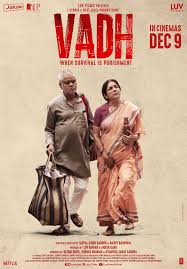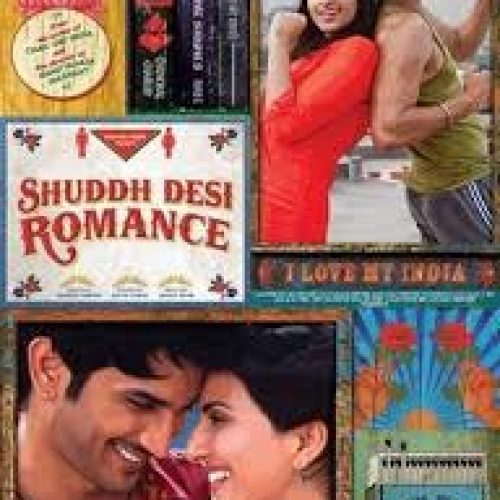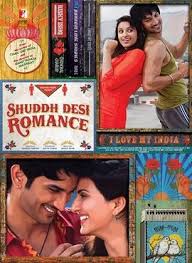When morality meets desperation, the result is a gripping tale of survival and redemption. Directed by Jaspal Singh Sandhu and Rajeev Barnwal, Vadh is a taut thriller-drama that explores the complex interplay of crime, morality, and justice. Starring Sanjay Mishra and Neena Gupta in pivotal roles, the film is set in a small-town India that throbs with hidden tensions and unspoken truths. With its mix of gritty realism and emotional depth, it offers a dark yet compelling look at human nature when pushed to the brink.
The story centers on Shambhunath Mishra, a retired schoolteacher struggling to make ends meet with his wife, Manju. Living a modest and largely uneventful life, their world takes a sinister turn when they are cornered by circumstances that force them to make a shocking choice. What begins as a slice-of-life drama gradually unfolds into a suspenseful tale of crime and conscience. The twists and turns of the narrative keep the audience on edge, but the real strength of the film lies in its exploration of human frailty and the lengths people will go to protect their loved ones.
Sanjay Mishra delivers a career-defining performance as Shambhunath. Known primarily for his comic roles, he completely reinvents himself in this dark, intense role. His portrayal of a man burdened by guilt, fear, and determination is so layered that it feels raw and haunting. Neena Gupta, as Manju, is equally impressive, playing the quiet yet resolute wife with subtlety and grace. The chemistry between the two actors is palpable, their silences speaking volumes about their shared pain and resilience. Together, they anchor the film with performances that feel both authentic and heartbreaking.
The direction by Sandhu and Barnwal is meticulous, with a clear focus on building tension through atmosphere rather than overt action. The directors use the small-town setting to great effect, creating a world that feels both suffocating and eerily familiar. The slow unraveling of the story is deliberate, forcing the audience to sit with the characters’ dilemmas and choices. While this pacing might feel slow to some, it adds to the film’s immersive quality, drawing viewers into its morally ambiguous world.
Visually, the film is a standout. Cinematographer Sapan Narula captures the bleakness of the Mishra household and the oppressive environment of the town with stark precision. The use of dim lighting and muted colors reflects the characters’ internal struggles and the grim tone of the narrative. The camera often lingers on seemingly mundane objects—an old fan, a creaking chair—turning them into symbols of decay and entrapment. This visual storytelling adds depth to the film, making it as much a psychological exploration as a narrative one.
The music and sound design subtly enhance the tension without overpowering the narrative. The background score is minimal yet effective, often using silence to amplify the emotional weight of a scene. The sparing use of music ensures that the focus remains on the story and the performances, adding to the film’s raw, unfiltered feel.
Thematically, the film delves deep into questions of morality, justice, and the societal pressures that often drive individuals to unthinkable actions. It doesn’t offer easy answers, instead presenting a complex moral landscape where right and wrong blur. The Mishras’ descent into crime is portrayed with empathy, forcing viewers to grapple with their own judgments about morality and necessity. This layered storytelling makes the film not just a thriller but also a profound character study.
One of the film’s most commendable aspects is its attention to detail. The production design captures the essence of a small-town home, from peeling walls to cluttered shelves, creating an environment that feels lived-in and authentic. The costumes, too, are understated, reflecting the simplicity of the characters’ lives. This commitment to realism enhances the credibility of the story, grounding its dramatic moments in a world that feels entirely plausible.
However, the film is not without its flaws. The pacing, while deliberate, might test the patience of viewers accustomed to faster narratives. Certain subplots, such as the interactions with secondary characters, feel underdeveloped, leaving loose ends that could have been explored further. Despite these minor shortcomings, the film remains an engrossing and thought-provoking experience.
In conclusion, this is a masterful blend of suspense, emotion, and social commentary. It’s a film that challenges its audience, asking them to step into the shoes of its morally conflicted characters and question their own beliefs about justice and survival. Anchored by outstanding performances from Sanjay and Neena, and supported by strong direction and evocative visuals, it stands as a testament to the power of storytelling. Recommended for fans of slow-burn thrillers and character-driven dramas, this film is a haunting reminder of the fragility of human morality—and the resilience of the human spirit.







